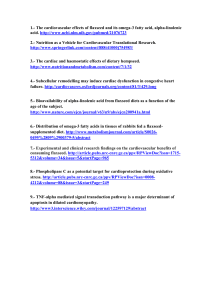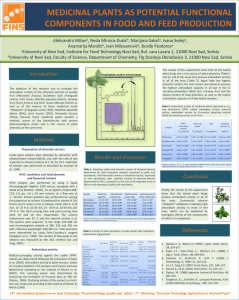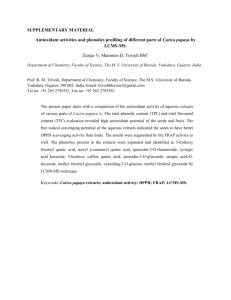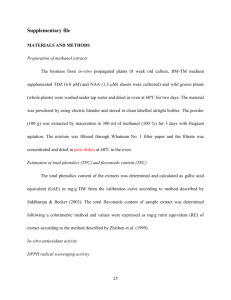Research Journal of Applied Sciences, Engineering and Technology 10(9): 968-979,... DOI: 10.19026/rjaset.10.1863
advertisement
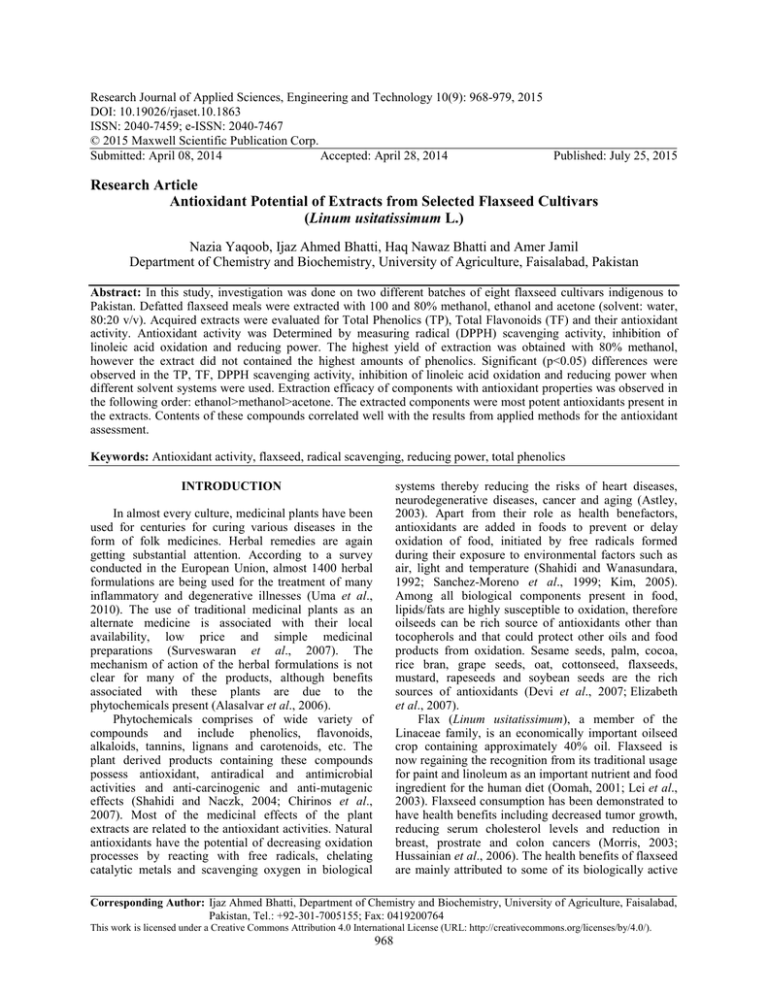
Research Journal of Applied Sciences, Engineering and Technology 10(9): 968-979, 2015 DOI: 10.19026/rjaset.10.1863 ISSN: 2040-7459; e-ISSN: 2040-7467 © 2015 Maxwell Scientific Publication Corp. Submitted: April 08, 2014 Accepted: April 28, 2014 Published: July 25, 2015 Research Article Antioxidant Potential of Extracts from Selected Flaxseed Cultivars (Linum usitatissimum L.) Nazia Yaqoob, Ijaz Ahmed Bhatti, Haq Nawaz Bhatti and Amer Jamil Department of Chemistry and Biochemistry, University of Agriculture, Faisalabad, Pakistan Abstract: In this study, investigation was done on two different batches of eight flaxseed cultivars indigenous to Pakistan. Defatted flaxseed meals were extracted with 100 and 80% methanol, ethanol and acetone (solvent: water, 80:20 v/v). Acquired extracts were evaluated for Total Phenolics (TP), Total Flavonoids (TF) and their antioxidant activity. Antioxidant activity was Determined by measuring radical (DPPH) scavenging activity, inhibition of linoleic acid oxidation and reducing power. The highest yield of extraction was obtained with 80% methanol, however the extract did not contained the highest amounts of phenolics. Significant (p<0.05) differences were observed in the TP, TF, DPPH scavenging activity, inhibition of linoleic acid oxidation and reducing power when different solvent systems were used. Extraction efficacy of components with antioxidant properties was observed in the following order: ethanol>methanol>acetone. The extracted components were most potent antioxidants present in the extracts. Contents of these compounds correlated well with the results from applied methods for the antioxidant assessment. Keywords: Antioxidant activity, flaxseed, radical scavenging, reducing power, total phenolics systems thereby reducing the risks of heart diseases, neurodegenerative diseases, cancer and aging (Astley, 2003). Apart from their role as health benefactors, antioxidants are added in foods to prevent or delay oxidation of food, initiated by free radicals formed during their exposure to environmental factors such as air, light and temperature (Shahidi and Wanasundara, 1992; Sanchez-Moreno et al., 1999; Kim, 2005). Among all biological components present in food, lipids/fats are highly susceptible to oxidation, therefore oilseeds can be rich source of antioxidants other than tocopherols and that could protect other oils and food products from oxidation. Sesame seeds, palm, cocoa, rice bran, grape seeds, oat, cottonseed, flaxseeds, mustard, rapeseeds and soybean seeds are the rich sources of antioxidants (Devi et al., 2007; Elizabeth et al., 2007). Flax (Linum usitatissimum), a member of the Linaceae family, is an economically important oilseed crop containing approximately 40% oil. Flaxseed is now regaining the recognition from its traditional usage for paint and linoleum as an important nutrient and food ingredient for the human diet (Oomah, 2001; Lei et al., 2003). Flaxseed consumption has been demonstrated to have health benefits including decreased tumor growth, reducing serum cholesterol levels and reduction in breast, prostrate and colon cancers (Morris, 2003; Hussainian et al., 2006). The health benefits of flaxseed are mainly attributed to some of its biologically active INTRODUCTION In almost every culture, medicinal plants have been used for centuries for curing various diseases in the form of folk medicines. Herbal remedies are again getting substantial attention. According to a survey conducted in the European Union, almost 1400 herbal formulations are being used for the treatment of many inflammatory and degenerative illnesses (Uma et al., 2010). The use of traditional medicinal plants as an alternate medicine is associated with their local availability, low price and simple medicinal preparations (Surveswaran et al., 2007). The mechanism of action of the herbal formulations is not clear for many of the products, although benefits associated with these plants are due to the phytochemicals present (Alasalvar et al., 2006). Phytochemicals comprises of wide variety of compounds and include phenolics, flavonoids, alkaloids, tannins, lignans and carotenoids, etc. The plant derived products containing these compounds possess antioxidant, antiradical and antimicrobial activities and anti-carcinogenic and anti-mutagenic effects (Shahidi and Naczk, 2004; Chirinos et al., 2007). Most of the medicinal effects of the plant extracts are related to the antioxidant activities. Natural antioxidants have the potential of decreasing oxidation processes by reacting with free radicals, chelating catalytic metals and scavenging oxygen in biological Corresponding Author: Ijaz Ahmed Bhatti, Department of Chemistry and Biochemistry, University of Agriculture, Faisalabad, Pakistan, Tel.: +92-301-7005155; Fax: 0419200764 This work is licensed under a Creative Commons Attribution 4.0 International License (URL: http://creativecommons.org/licenses/by/4.0/). 968 Res. J. App. Sci. Eng. Technol., 10(9): 968-979, 2015 components, which include its exceptionally high content of α-linolenic acid, lignans, protein, phenolic acids, flavonoids and related compounds (Tarpila et al., 2005; Hosseinian et al., 2006; Toure and Xueming, 2010). The extraction/isolation of antioxidant compounds from plant materials can be done using different techniques and selected solvents from the plant matrix. Solvent extraction is the most frequently used technique for isolation of plant antioxidant, however, the yields and antioxidant efficiency of the resulting extracts is affected by the polarity of extracting solvent and solubility of isolated compounds (Ford et al., 1999; Charlet et al., 2002; Degenhardt et al., 2002; Sicilia et al., 2003). Polar solvents such as methanol and ethanol are often used for extraction of phenolics antioxidant from a plant matrix (Chatha et al., 2006). In view of the potential neutraceutical attributes of flaxseed, there is substantial focus on screening and investigating its phytochemicals and antioxidant components. The main objective of the present study was assessment of the extraction efficacy of methanol, ethanol and acetone and their aqueous solutions (80%) for the isolation of components with antioxidant properties from different flaxseeds cultivars grown in different regions of Pakistan. Determination of Total Phenolics (TP): The total TP was assessed using Folin-Ciocalteu reagent based analysis as described by Chaovanalikit and Wrolstad (2004). Briefly, 50 mg of dried flaxseed extract was mixed with 0.5 mL of Folin-Ciocalteu reagent and 7.5 mL of deionized water. The mixture was held at room temperature for 10 min and 1.5 mL of 20% sodium carbonate (w/v) was added. The mixture was heated in a water bath at 40°C for 20 min and then cooled in an ice bath; finally absorbance at 755 nm was measured (HitachiU-2001 spectrophotometer, model 121-0032). Amounts of TP were calculated using a calibration curve for gallic acid (10-100 ppm) (R = 0.9986). The results were expressed as Gallic acid equivalents (mg GAE 100/g of dry weight). All samples were analyzed three times and the results were averaged. Determination of Total Flavonoids (TF): Determination of total flavonoids was performed following the procedure by Dewanto et al. (2002). One milliliter of aqueous extract containing 0.1 g/mL of dry matter was placed in a 10 mL volumetric flask, then 5 mL of distilled water added followed by 0.3 mL of 5% NaNO2. After 5 min, 0.6 mL of 10% AlCl3 was added, after next 5 min, 2 mL of 1 M NaOH was added and finally volume was adjusted with distilled water. The solution was mixed and the absorbance measured at 510 nm. The amounts of TF were expressed as Catechin Equivalents (CE) per 100 g dry matter. All samples were analyzed in triplicate and results were averaged. MATERIALS AND METHODS Flaxseeds: Samples of flaxseeds were procured from Ayub Agriculture Research Institute, Faisalabad and National Agriculture Research Centre Islamabad, Pakistan representing the cultivars grown in arid and irrigated regions of Pakistan. DPPH radical scavenging assay: The free radical scavenging activity of flaxseed extracts was measured using procedure described by Iqbal et al. (2005). Briefly, to 1.0 mL of flaxseed extract containing 25 µg/mL of dry matter in methanol, 5.0 mL of freshly prepared solution of 2, 2-Diphenyl-1-Picrylhydrazyl (DPPH) at concentration 0.025 g/L was added. Absorbance at 0, 0.5, 1, 2, 5 and 10 min, respectively was measured at 515 nm (Hitachi U-2001 spectrophotometer, model 121-0032). The absorbance was measured during the 5th min and used for comparison of radical scavenging activity of flaxseed extracts. Chemicals and reagents: Linoleic acid (±), FolinCiocalteu’s phenol regent, catechin and gallic acid were purchased from Sigma Chemical Co. (St. Louis, MO, USA). All other chemicals and reagents were purchased from E. Merck (Darmstadt, Germany), unless stated otherwise. All the chemicals used for the study were of analytical grade. Defatting and extraction of flaxseed: Samples of flax seeds were ground in a grinding mill (Tector-Cemotec 1090 sample mill, Hognas, Sweden). The seeds were defatted by using the Folch method. Each defatted sample (10 g) was extracted with 100 mL of absolute and 80% aqueous methanol, ethanol and acetone solution in water (80:20 v/v) using an orbital shaker (Gallenkamp, UK) for 8 h at room temperature. The extract was separated from the solids by filtration with Whatman No. 1 filter paper. The remaining solids were extracted twice with the same solvent and extracts were combined. The extracts were concentrated under reduced pressure at 45°C, in a rotary evaporator (EYELA, Tokyo, Japan). Concentrated extracts were stored in a refrigerator (4°C) until analyzed. Antioxidant activity determination in linoleic acid system: The antioxidant activity of flaxseed extracts was determined in terms of measurement of % inhibition of peroxidation in a linoleic acid model system following the method reported by Iqbal et al. (2005). Dried extracts (5 mg) were added to a solution mixture of linoleic acid (0.13 mL), 99.8% ethanol (10 mL) and 10 mL of 0.2 M sodium phosphate buffer (pH 7). Total mixture was diluted to 25 mL with distilled water. The solution was incubated at 40°C and the degree of oxidation was measured using the thiocyanate method. Ten milliliter of ethanol (75%), 0.2 mL of an 969 Res. J. App. Sci. Eng. Technol., 10(9): 968-979, 2015 aqueous solution of ammonium thiocyanate (30%), 0.2 mL of sample solution and 0.2 mL of FeCl2 solution (20 mM in 3.5% HCl) were added sequentially. After 3 min of stirring, the absorption values of mixture measured at 500 nm were reported as the peroxide content. A control was performed with linoleic acid, but without extracts. The synthetic antioxidant (Tertiarybutylhydro Quinone TBHQ) was used as a positive control. The antioxidant activity was calculated as percentage of inhibition relative to the control using the following equation: RESULTS AND DISCUSSION Extract yield: The extract yields (g/100 g of dried plant material) from seeds of different cultivars of flaxseed using different solvents are presented in the Table 1. The yields of antioxidant components varied significantly (p<0.05) when different solvents were employed for their extraction. The extraction ability of different solvents for the recovery of antioxidant components followed the order: 80% methanol>80% ethanol>100% methanol>100% ethanol>80% acetone> 100% acetone. The results indicate that higher polarities affected the solubility and hence the extract yields because phenolics are more soluble in organic solvents containing a modest amount of water (10 to 20% water) (Hsu et al., 2006). Among other contributing factors, efficiency of the extraction is also affected by the techniques used and the solubility of extracted compounds present in the matrix (Siddhuraju and Becker, 2003; Chatha et al., 2006). The higher extract yield obtained with the 80% organic solvents was in good agreement with the study conducted by Anwar and Przybylski (2012), who reported the maximum yield when flaxseed of Canadian origin was extracted with aqueous methanol. Kasote et al. (2011) extracted defatted flaxseed meal with n-butanol but recovery of phenolics was very low. where, AA = Inhibition of peroxidation β = Absorbance of sample at 72 h β* = Absorbance of control at 72 h α = Absorbance of sample at 0 h α* = Absorbance of control at 0 h Determination of reducing power: The reducing power of the extracts was determined according to the procedure described by Yen et al. (2000), with slight modification. Equivalent volumes of flaxseed extract containing 2.5-10.0 mg of dry matter was mixed with sodium phosphate buffer (5.0 mL, 0.2 M, pH 6.6) and potassium ferricyanide (5.0 mL, 1.0%); the mixture was incubated at 50°C for 20 min. Then 5 mL of 10% trichloroacetic acid was added and the mixture was centrifuged at 980 g for 10 min at 5°C in refrigerated centrifuge (CHM-17; Kokusan Denki, Tokyo, Japan). The upper layer of the solution (5.0 mL) was diluted with 5.0 mL of distilled water and ferric chloride (1.0 mL, 0.1%) and absorbance read at 700 nm (Hitachi U2001). The measurement was done in triplicate and results averaged. Total phenolics contents: The total phenolic compounds extracted from different flaxseed cultivars using different solvents are presented in Table 2. Among different solvents used in this study, 80% aqueous ethanol provided the best efficiency for extracting phenolics. The amount of TP extracted from different flaxseeds, ranged from 1199-3184 (GAE mg/100 g of dry defatted sample). However, ethanolic extracts of all flaxseeds contained significantly (p<0.05) higher amounts of total phenolics as compared to the other solvents, ranging from 2681-3184 (GAE mg/100 g of defatted sample). Others have reported that greater amounts of phenolics can be extracted with more polar solvents such as aqueous methanol/ethanol as compared with absolute methanol/ethanol (Siddhuraju and Becker, 2003; Sultana et al., 2009). Statistical analysis: All experiments were done as independent triplicates of two batches of each flaxseed cultivar and data were reported as the mean±S.D. (Standard Deviation). Data were analyzed by Analysis of Variance (ANOVA) and the Duncan Multiple Range (DMR) test using MINITAB 2000 Version 16.1 statistical software (MINITAB Inc. State College, PA, USA). A probability value of p<0.05 was considered to denote statistically significant differences. Table 1: Effect of extracting solvents (%) on the extract yield of different cultivars of flaxseed Cultivars ------------------------------------------------------------------------------------------------------------------------------------------------------Solvents Chandni LS-108 LS-105 LS-99 LS-33 LS-31 LS-29 LS-13 10.42±0.54c 10.33±0.30b 9.98±0.48b 8.89±0.45b 6.75±0.28b 9.50±0.51b 5.98±0.36b 100% methanol 10.47±0.52b a a a a a a a 80% methanol 13.02±0.69 12.89±0.32 13.21±0.37 11.89±0.21 10.49±0.45 7.81±0.31 11.67±0.48 7.98±0.38a 100% ethanol 9.43±0.58c 9.33±0.12d 9.87±0.27b 8.27±0.23c 7.90±0.25c 5.88±0.44c 7.48±0.49c 4.24±0.31c 80% ethanol 10.75±0.40b 10.44±0.38b 10.29±0.37b 9.34±0.32b 8.98±0.47c 7.97±0.48a 9.04±0.33b 6.02±0.13b e e d d d d d 100% acetone 6.41±0.46 6.25±0.52 6.87±0.98 6.27±0.43 5.99±0.15 4.94±0.18 5.58±0.15 4.16±0.15d 80% acetone 7.88±0.35d 6.98±0.18e 7.18±0.29c 7.28±0.30e 6.88±0.30d 5.77±0.27c 6.81±0.25c 5.82±0.24c Values (mean±S.D.) are average of three samples of each cultivar, analyzed individually in triplicate (n = 2×3×3), (p<0.05); Different letters in superscript (columns) indicate significant differences among different solvents 970 Res. J. App. Sci. Eng. Technol., 10(9): 968-979, 2015 Table 2: Effect of extracting solvents on total phenolic contents (GAE mg/100 g of dry matter) of the different cultivars of flaxseed Cultivars -----------------------------------------------------------------------------------------------------------------------------------------------------Chandni LS-108 LS-105 LS-99 LS-33 LS-31 LS-29 LS-13 Solvents 2650±70c 2530±75c 2455±55c 2300±90c 2353±65c 2303±60c 2270±85c 100% methanol 2600±45c 80% methanol 2969±12b 3009±91b 3021±85b 2820±75b 2632±66b 2598±58b 2603±41b 2429±70b d d d d d d d 100% ethanol 2348±48 2307±86 2292±53 2303±66 2202±71 2150±91 2190±78 2085±59d 80% ethanol 3181±88a 3124±75a 3184±101a 3104±58a 2892±66a 2845±69a 2875±82a 2681±81a 100% acetone 1399±40f 1363±61f 1370±49f 1301±35f 1205±31f 1199±23f 1276±41f 1207±36f 80% acetone 1856±70e 1795±83e 1703±63e 1653±79e 1598±72e 1625±60e 1560±99e 1484±94e Values (mean±S.D.) are average of three samples of each cultivar, analyzed individually in triplicate (n = 2×3×3), (p<0.05); Different letters in superscript (columns) indicate significant differences among different solvents Table 3: Effect of extracting solvents on total flavonoid contents (CE mg/100 g of dry matter) of the different cultivars of flaxseed Cultivars ------------------------------------------------------------------------------------------------------------------------------------------------------Chandni LS-108 LS-105 LS-99 LS-33 LS-31 LS-29 LS-13 Solvents 315.6±5.1c 298.0±12.7c 274.0±11.5c 219.6±6.0c 201.6±9.0c 257.0±9.8c 189.0±7.8c 100% methanol 320.6±10.0c 80% methanol 460.3±23.0a 414.3±19.4a 428.5±21.2a 399.0±18.2a 352.0±18.0a 274.0±11.5a 286.3±9.5a 251.3±8.6a d d d d d d d 201.3±6.0 191.0±8.3 162.6±5.5 174.0±5.2 120.0±4.5 129.5±4.8 99.3±3.0d 100% ethanol 146.0±8.5 342.0±2.6b 329.0±15.6b 326.3±13.7b 296.2±11.9b 231.0±13.0b 219.3±10.5b 201.3±12.5b 80% ethanol 371.3±14.1b 100% acetone 125 .0±8.5e 115.0±5.9e 133.0±10.1f 113.6±6.1f 98.5±8.1f 94.8±6.5e 126.6±7.5e 98.3±3.5d 185.3±6.1d 176.0±4.5e 130.6±7.1e 125.0±12.6e 99.3±5.8e 132.6±6.3e 108.3±1.5e 80% acetone 148.6±5.1d Values (mean±S.D.) are average of three samples of each cultivar, analyzed individually in triplicate (n = 2×3×3), (p<0.05); Different letters in superscript (columns) indicate significant differences among different solvents The results from this study are in close agreement with the previous reports in (Anwar and Przybylski, 2012). It is generally accepted that phenolics are among the most abundant phytochemicals present in cereals, grains, fruits and many other plant origin sources. However, it is difficult to compare the data since the contents of phenolic acids tremendously depend on the growing atmosphere, the techniques and different conditions used for extraction. The amounts of total phenolics extracted from different Pakistani flaxseed cultivars are in close agreement with the previous findings by Anwar and Przybylski (2012) and Oomah et al. (1995a, b) for Canadian flaxseed. However, the phenolic contents in Pakistani flaxseed cultivars are comparatively higher than the values (72.75 and 162 to 362 mg/100 g of flaxseed) reported for cultivars grown in Chile and Egypt, respectively (Gutiérrez et al., 2010; El-Beltagi et al., 2007). the TFC observed in this study in the flaxseed samples from Pakistan are significantly greater than previously reports (12.9-20.0 mg/100 g of flaxseed) for the Egyptian flaxseed varieties (El-Beltagi et al., 2007). DPPH radical scavenging activity: The DPPH radical scavenging assay has been widely used to assess the antioxidant ability of various plants extracts and natural products (Porto et al., 2000). The results of radical scavenging activities as measured by DPPH of different flaxseed extracts from Pakistan are shown in Fig. 1. The flaxseed extracts showed significant (p<0.05) radical scavenging capacity towards DPPH radicals (36-84.23%) as compared to TBHQ (92%). The extracts produced with different solvents show significant variation in the DPPH scavenging activity (p<0.05). The substantial DPPH radical scavenging capacity of the tested flaxseed extracts could be explained by the presence of appreciable amounts of total phenolics and flavonoids in these extracts (Ardestani and Yazdanparast, 2007). Our results showed similar trend with the previous findings. Barbary et al. (2010) reported the DPPH radical scavenging activity of Egyptian flaxseed extract in the range of 81.6 to 89.3%. Zanwar et al. (2010) reported the DPPH radical scavenging to be 78.38%, for a 50% aqueous ethanolic extract of defatted flaxseed of Indian origin. Ether insoluble phenolic components from butanol fraction of defatted Indian flaxseed meal showed moderate DPPH radical scavenging activity as compared to the standard antioxidants Butylhydroxyanisol (BHA) and Butylhydroxytoluene (BHT) (Kasote et al., 2011). Total flavonoids: The amount of Total Flavonoids (TF) extracted from flaxseeds using different solvents ranged from 94.8 to 460 mg CE 100/g of dry matter for different cultivars showing considerable variations among solvent used (p<0.05) (Table 3). The results showed that 80% methanolic extracts contained the greatest amount of flavonoids among the solvents examined, whereas pure acetone extracts had the lowest amounts of flavonoids. Chandni cultivar was observed to contain the greatest TF contents (460 mg CE 100/g of dry matter). The amount varied from 25-56 mg 100/g of seed and is in close agreement with values reported by Oomah (2001) and Oomah et al. (1996a, b) for different Canadian flaxseed cultivars (30.2-83.5 mg and 35-71 mg/100 g of flaxseed, respectively). However, 971 Res. J. App. Sci. Eng. Technol., 10(9): 968-979, 2015 Fig. 1: Effect of extracting solvents on the free radical scavenging activity of the extracts from different cultivars of flaxseed All the experiments were performed in triplicate and the values represented as mean±S.D. Fig. 2: Effect of extracting solvents on inhibition of peroxidation of the extracts of different cultivars of flaxseed All the experiments were performed in triplicate and the values represented as mean±S.D. 972 Res. J. App. Sci. Eng. Technol., 10(9): 968-979, 2015 Fig. 3: Effects of extracting solvents on reducing power of flaxseed (chandni) extracts, expressed as absorbance at 700 nm All the experiments were done in triplicates and the values represented as mean±S.D. Fig. 4: Effects of extracting solvents on reducing power of flaxseed (LS-108) extracts, expressed as absorbance at 700 nm All the experiments were done in triplicates and the values represented as mean±S.D. 973 Res. J. App. Sci. Eng. Technol., 10(9): 968-979, 2015 Fig. 5: Effects of extracting solvents on reducing power of flaxseed (LS-105) extracts, expressed as absorbance at 700 nm All the experiments were done in triplicates and the values represented as mean±S.D. Fig. 6: Effects of extracting solvents on reducing power of flaxseed (LS-99) extracts, expressed as absorbance at 700 nm All the experiments were done in triplicates and the values represented as mean±S.D. 974 Res. J. App. Sci. Eng. Technol., 10(9): 968-979, 2015 Fig. 7: Effects of extracting solvents on reducing power of flaxseed (LS-33) extracts, expressed as absorbance at 700 nm All the experiments were done in triplicates and the values represented as mean±S.D. Fig. 8: Effects of extracting solvents on reducing power of flaxseed (LS-31) extracts, expressed as absorbance at 700 nm All the experiments were done in triplicates and the values represented as mean±S.D. 975 Res. J. App. Sci. Eng. Technol., 10(9): 968-979, 2015 Fig. 9: Effects of extracting solvents on reducing power of flaxseed (LS-29) extracts, expressed as absorbance at 700 nm All the experiments were done in triplicates and the values represented as mean±S.D. Fig. 10: Effects of extracting solvents on reducing power of flaxseed (LS-13) extracts, expressed as absorbance at 700 nm All the experiments were done in triplicates and the values represented as mean±S.D. Inhibition of peroxidation: The antioxidant activity of different varieties of Pakistani flaxseed extracts was determined by inhibition of per-oxidation in a linoleic acid model system using thiocyanate method (Yen et al., 2000). All the flaxseed extracts exhibited appreciable inhibition of per-oxidation ranging from 26 976 Res. J. App. Sci. Eng. Technol., 10(9): 968-979, 2015 to 81.29% and were compared with TBHQ having inhibition of per-oxidation 94.2% (Fig. 2). The 80% aqueous ethanolic and 80% methanolic extracts exhibited higher activities of inhibition of per-oxidation as compared to the other solvent systems. This might be related to the fact that phenolic compounds are preferably extracted in moderately polar solvents as compared to nonpolar solvents in terms of the extraction of phenolic compounds. The results are consistent with the previous reports showing that aqueous ethanolic extract of flaxseeds of Canadian show superior inhibition of per-oxidation as compared to pure ethanolic and methanolic extracts (Anwar and Przybylski, 2012). The potential of inhibition of peroxidation of lipid of flaxseed lignans in linoleic acid system has been reported to be comparable to BHT without any significant difference (Kitts et al., 1999; Anwar and Przybylski, 2012). radical chain reactions that chelate catalytic transition metals, as well as scavenge oxygen in food and biological systems (Kim, 2005; Shahidi, 1997). It is important to develop a relation between the various methods used to assess the properties of different antioxidants, so that some comprehensive and convenient protocols may be established for overall antioxidant activity evaluation of the plant materials. Evaluation of the antioxidant activity of a typical material with an assay based on one chemical reaction seems to be rather questionable, so there is a need to employ a multitude of tests to adequately assess antioxidant activity. In the present study we used different antioxidant assays such as; the measurement of the total phenolic content, the total flavonoid content, inhibition of linoleic acid per-oxidation, the DPPH radical scavenging capacity and the reducing potential to evaluate the antioxidant activity of flaxseed extracts. The correlation between the results of different antioxidant assays are shown in Table 4. A very good correlation between TP and TF was observed (r = 0.8604), which could be supported by the previously reported trends (Siddhuraju and Becker, 2003). The present results also revealed that phenolic compounds are effective scavengers of free radicals as is evident by an excellent correlation between DPPH radical scavenging activity with TP (r = 0. 8874) and TF (r = 0.9196). A good correlation between % inhibition of linoleic acid per-oxidation and TP (r = 0.7720) and TF (r = 0.7844) and DPPH scavenging capacity assay (r = 0.7795) was established. Antioxidant activity of phenolic compounds is often associated with their redox properties, which allow them to act as reducing agents and results of this study supported this notion. An excellent correlation was observed between reducing power and TP and TF (r = 0.9054) and (r = 0.8169), respectively. A very good correlation (r = 0.8266) was also observed between reducing power and DPPH radical scavenging activity. Furthermore a reasonably good correlation (r = 0.7496) was observed between reducing power and inhibition of linoleic acid per-oxidation. The results are in accordance with the previous investigations (Amarowicz et al., 2006; Zanwar et al., 2010; Kasote et al., 2011; Anwar and Przybylski, 2012), who reported that flaxseed extracts are very rich in phenolics and act as powerful scavengers of free Reducing power: The data for the reducing potential of different flaxseed cultivar extracts prepared by different solvent systems is presented in Fig. 3 to 10. The reducing power of the tested flaxseed extracts in the concentration range of 25 to 100 (µg extract/mL) increased in a dose-dependent manner. The reducing power of the flaxseed extracts with 80% ethanol is superior as compared to other solvent systems. From the results regarding the reducing power it can be inferred that flaxseed extracts are capable of convert the free radicals to stable products by donating electrons. Hence, they can readily terminate the reactions initiated due to the presence of free radicals (Anwar and Przybylski, 2012). For concentrations of 100, 200, 300, 400 and 500 µg extract/mL of 50% aqueous ethanolic extract of flaxseed of Indian origin, the absorbance was observed to be 0.34, 0.44, 0.67, 0.72 and 0.88, respectively (Zanwar et al., 2010). Ether insoluble phenolic components from butanol fraction of defatted flaxseed meal were observed to have reducing potential close to the standard antioxidants BHA and BHT (Kasote et al., 2011). Anwar and Przybylski (2012) used FRAP assay for the antioxidant activity determination of flaxseed extracts. They found the reducing power to be dependent on the concentration of extract used. Comparison among results of different antioxidant activity assays: It is now well established that plant extracts possess antioxidant activities that interrupt free Table 4: Relationship between different antioxidant assays and presence of phenolic compounds as described by correlation coefficient Variables TPC TFC DPPHº scavenging Inhibition of per-oxidation Reducing power TPC 0.8604 0.8874 0.7720 0.9054 TFC 0.8604 0.9196 0.7844 0.8169 DPPH° scavenging 0.8874 0.9196 0.7795 0.8266 Inhibition of 0.7720 0.7844 0.7795 0.7496 peroxidation Reducing power 0.9054 0.8169 0.8266 0.7496 - 977 Res. J. App. Sci. Eng. Technol., 10(9): 968-979, 2015 radical and reactive oxygen species and also exhibit good reducing powers. Variations, as observed in the present investigation, for correlation coefficients among different antioxidant assays support the necessity to use multitude of assays to adequately assess antioxidant efficacy of usually complex mixture of antioxidative compounds present in plants, which often act with different scavenging mechanism. Ardestani, A. and R. Yazdanparast, 2007. Antioxidant and free radical scavenging potential of Achillea santolina extract. Food Chem., 104: 21-29. Astley, S.B., 2003. Dietary antioxidant-past, present and future. Trends Food Sci. Tech., 14: 93-98. Barbary, O.M., S.A. El-Sohaimy, M.A. El- Saadani and A.M.A. Zeitun, 2010. Antioxidant, antimicrobial and anti HCV, activities of lignin extracted from flaxseed. Res. J. Agric. Bio. Sci. 6(3): 247-256. Chaovanalikit, A. and R.E. Wrolstad, 2004. Total anthocyanins and total phenolics of fresh and processed cherries and their antioxidant properties. J. Food Sci., 69(1): 73-83. Charlet, S., L. Bensaddek, D. Raynaud, F. Gillet, F. Mesnard and M.A. Fliniaux, 2002. An HPLC method for the quantification of anhydrosecoisolariciresinol, application to the evaluation of flax lignan content. Plant Physiol. Bioch., 40: 225-229. Chatha, S.A.S., F. Anwar, M. Manzoor and J.R. Bajwa, 2006. Evaluation of the antioxidant activity of rice bran extracts using different antioxidant assays. Grasas Aceites., 57: 328-335. Chirinos, R., H. Rogez, D. Campos, R. Pedreschi and Y. Larondelle, 2007. Optimization of extraction conditions of antioxidant phenolic compounds from mashua (Tropaeolum tuberosum Ruíz and Pavón) tubers. Sep. Purif. Technol., 55(2): 217-225. Degenhardt, A., S. Habben and P. Winterhalter, 2002. Isolation of the lignan secoisolariciresinol diglucoside from flaxseed (Linum ustitatissimum L.) by high-speed counter-current chromatography. J. Chromatogr. A, 943: 299-302. Devi, R.R., A. Jayalekshmy and C. Arumghan, 2007. Antioxidant efficacy of phytochemical extracts from defatted rice bran in the bulk oil system. Food Chem., 104: 658-664. Dewanto, V., W. Adom and X. Liu, 2002. Thermal processing enhancing the nutritional value of tomatoes by increasing total antioxidant activity. J. Agr. Food Chem., 50(10): 3010-3014. El-Beltagi, H.S., Z.A. Salama and D.M. El-Hariri, 2007. Evaluation of fatty acids profile and the content of some secondary metabolites in seeds of different flax cultivars (Linum usitatissimum L.) Gen. Appl. Plant Physiol., 33(3-4): 187-202. Elizabeth, N.R.G., H. Annete, R.G.L. Francisco, F.I.P. Javier, Z.G. Graciela and J.G.I. Alberto, 2007. Antioxidant and antimutagenic activity of phenolic compounds in three different color groups of common beans cultivars. Food Chem., 103: 521-527. Ford, J.D., L.B. Davin and N.G. Lewis, 1999. Plant lignans and health: cancer chemoprevention and biotechnological opportunities. Basic Life Sci., 66: 675-694. CONCLUSION From the present investigation it can be concluded that 80% aqueous methanol and ethanol are the most effective solvents for the extraction of phenolic compounds from the defatted flaxseed while the pure ethanol and acetone were least effective as compared to the other solvent systems. The phenolics and flavonoid contents in Pakistani flaxseed cultivars are quite high and comparable with the previous reports for flaxseed grown in different regions of the world. The antioxidant activities determined by different in vitro models, radical scavenging ability, inhibition of peroxidation in linoleic acid systems and reducing power, show that the extract of different flaxseed cultivars exhibit considerable activities when compared to the standard synthetic antioxidant. The antioxidant activities are also comparable to the flaxseed grown in different parts of the world. Flaxseed grown in different areas of Pakistan has great antioxidant potential hence can be used as viable source of natural antioxidants to be used in food, cosmetics and health industry. ACKNOWLEDGMENT The work presented is a part of Ph.D. studies of Ms. Nazia Yaqoob. Authors are thankful to the Higher Education Commission of Pakistan for the funding of the project under the Indigenous Ph.D. 5000 Scholarship Scheme. Authors are also thankful to the scientists of Ayub Agriculture Research Institue, Faisalabad and National Agriculture Research Center, Islamabad, Pakistan for the provision of flaxseed samples grown in different areas of Pakistan. REFERENCES Alasalvar, C., M. Karamac, R. Amarowicz and F. Shahidi, 2006. Antioxidant and antiradical activities in extracts of hazelnut kernel (Corylus avellana L.) and hazelnut green leafy cover. J. Agr. Food Chem., 54: 4826-4832. Amarowicz, R., P.K.J.P.D. Wanasundara and F. Shahidi, 2006. Chromatographic separation of flaxseed phenolics. Nahrung, 38: 520-526. Anwar, F. and R. Przybylski, 2012. Effect of solvents extraction on total phenolics and antioxidant activity of extracts from flaxseed (Linum usitatissimum L.). Acta Sci. Pol. Technol. Aliment., 11(3): 293-301. 978 Res. J. App. Sci. Eng. Technol., 10(9): 968-979, 2015 Gutiérrez, C., M. Rubilar, C. Jara1, M. Verdugo, J. Sineiro and C. Shene, 2010. Flaxseed and flaxseed cake as a source of compounds for food industry. J. Soil Sci. Plant Nutr., 10(4): 454-463. Hosseinian, F.S., A.D. Muir, N.D. Westcott and E.S. Krol, 2006. Antioxidant capacity of flaxseed lignans in two model systems. J. Am. Oil Chem. Soc., 83(10): 835-840. Hsu, B., I.M. Coupar and K. Ng, 2006. Antioxidant activity of hot water extract from the fruit of the Doum palm, Hyphaene thebaica. Food Chem., 98: 317-328. Iqbal, S., M.I. Bhanger and F. Anwar, 2005. Antioxidant properties and components of some commercially available varieties of rice bran in Pakistan. Food Chem., 93: 265-272. Kasote, D.M., M.V. Hegde and K.K. Deshmukh, 2011. Antioxidant activity of phenolic components from n-butanol fraction (PC-BF) of defatted flaxseed meal. Am. J. Food Technol., 6: 604-612. Kim, J.S., 2005. Radical scavenging capacity and antioxidant activity of E vitamer fraction in rice bran. J. Food Sci., 70(3): 208-213. Kitts, D.D., Y.V. Yuan, A.N. Wijewickreme and L.U. Thompson, 1999. Antioxidant activity of the flaxseed lignan secoisolariciresinol diglycoside and its mammalian lignan metabolites enterodiol and enterolactone. Mol. Cell Biochem., 202: 91-100. Lei, B., E.C.Y. Li Chen, B.D. Oomah and G. Mazza, 2003. Distribution of cadmium-binding components in flax (Linum usitatissium L.) seed. J. Agr. Food Chem., 51: 814-821. Morris, D.M., 2003. Flax: A Health and Nutrition Primer. Flax Council of Canada, Winnipeg, Manitoba, Canada, pp: 9-19. Oomah, B.D., 2001. Flaxseed as a functional food source. J. Sci. Food Agr., 81: 889-894. Oomah, B.D., E.O. Kenaschuk and G. Mazza, 1995a. Phenolic acids in flaxseed. J. Agr. Food Chem., 43: 2016-2019. Oomah, B.D., E.O. Kenaschuk. W. Cui and G. Mazza, 1995b. Variation in the composition of location and year. Proceeding of the 56th Flax Institute of the United States, Fargo, ND., pp: 77-80. Oomah, B.D., G. Mazza and E.O. Kenaschuk, 1996a. Flavonoid content of flaxseed. Influence of cultivar and environment. Euphytica, 90(2): 163-167. Oomah, B.D., G. Mazza and R. Przybylski, 1996b. Comparison of flaxseed meal lipids extracted with different solvents. LWT-Food Sci. Technol., 29: 654-658. Sanchez-Moreno, C., J.A. Larrauri and F. SauraCalixto, 1999. Free radical scavenging capacity and inhibition of lipid oxidation of wines, grape juices and related polyphenolic constituents. Food Res. Int., 32: 407-412. Shahidi, F., 1997. Natural Antioxidants, Chemistry, Health Effects and Applications. AOCS Press, Champaign, Illinois, USA. Shahidi, F. and P.K. Wanasundara, 1992. Phenolic antioxidants. Crit. Rev. Food Sci., 32(1): 67-103. Shahidi, F. and M. Naczk, 2004. Biosynthesis, Classification, and Nomenclature of Phenolics in Food and Nutraceuticals. In: Phenolics in Food and Nutraceuticals. CRC Press, Boca Raton, FL, pp: 1-16. Sicilia, T., H.B. Niemeyer, D.M. Honig and M. Metzler, 2003. Identification and stereochemical characterization of lignans in flaxseed and pumpkin seeds. J. Agr. Food Chem., 51: 1181-1188. Siddhuraju, P. and K. Becker, 2003. Antioxidant properties of various extracts of total phenolic constituents from three different agroclimatic origins of drumstick tree (Moringa oleifera Lam.) leaves. J. Agr. Food Chem., 51: 2144-2155. Sultana, B., F. Anwar and M. Ashraf, 2009. Effect of extraction solvent/technique on the antioxidant activity of selected medicinal plant extracts. Molecules, 14: 2167-2180. Surveswaran, S., Y.Z. Cai, H. Croke and M. Sun, 2007. Systematic evaluation of natural phenolic antioxidants from 133 Indian medicinal plants. Food Chem., 102: 938-953. Tarpila, A., T. Wennberg and S. Tarpila, 2005. Flaxseed as a functional food. Curr. Top. Nutraceut. R., 3(3): 167-188. Toure, A. and X. Xueming, 2010. Lignans: Source, biosynthesis, metabolism, antioxidant activity, bioactive components and health benefits. Compr. Rev. Food Sci. F., 9: 261-269. Uma, D.B., C.W. Ho, W.M. Wan Aida. 2010. Optimization of Extraction Parameters of Total Phenolic Compounds from Henna (Lawsonia inermis) Leaves. Sains Malays., 39(1): 119-128. Yen, G.C., P.D. Duh and D.Y. Chuang, 2000. Antioxidant activity of anthraquinones and anthrone. Food Chem., 70: 307-315. Zanwar, A.A., M.V. Hegde and S.L. Bodhankar, 2010. In vitro antioxidant activity of ethanolic extract of Linum usitatissimum. Pharmacology, 1: 683-696. 979

